Boost Brand Name Reach with Transit Advertising Philippines
Boost Brand Name Reach with Transit Advertising Philippines
Blog Article
Recognizing the Duty of Transportation Marketing in Enhancing Brand Name Exposure and Customer Interaction
Transit advertising has emerged as a critical aspect in the advertising landscape, supplying one-of-a-kind possibilities for brands to raise their exposure and involve customers properly. With the ability to reach a restricted and varied audience during their everyday commutes, these advertising approaches are not just about visibility; they are concerning creating purposeful connections with possible consumers. As we check out the diverse advantages and cutting-edge strategies within transit advertising, it comes to be important to think about how these components jointly affect customer perception and behavior, increasing concerns concerning their lasting effect on brand name commitment.
Interpretation of Transit Advertising And Marketing
Transportation advertising describes the method of promoting products, solutions, or brand names via ads put around public transport systems. This form of marketing includes a selection of positionings, consisting of posters on trains and buses, digital screens at transportation terminals, and wraps on the exterior of cars. It aims to get to a varied target market, taking advantage of the high foot web traffic related to public transportation.
Transportation advertising and marketing is tactically positioned to catch the attention of travelers, who typically invest significant time traveling or waiting. By integrating ads right into the everyday regimens of individuals, brand names can produce a lasting perception and foster brand name acknowledgment. The tool is particularly reliable in urban environments, where public transport is a key mode of traveling.
Furthermore, transit marketing can help with local targeting, enabling services to get to details demographics based upon transportation paths and terminal places. As metropolitan populations grow and using public transport increases, this advertising approach has actually gotten prestige as a crucial element of incorporated marketing methods. The vibrant nature of transportation advertising, combined with its ability to engage consumers in a restricted setting, emphasizes its importance in modern advertising and marketing practices.
Advantages of Transportation Advertising
The effectiveness of transportation advertising and marketing lies in its capacity to supply a wide range of advantages to brands looking for to improve exposure and involvement. Among the main benefits is the considerable reach it offers; transportation advertisements can successfully target diverse demographics throughout metropolitan areas, getting to both travelers and pedestrians alike. This broad exposure considerably increases brand recognition.
Another advantage is the high frequency of impressions. As transportation lorries follow established courses and quit at numerous locations, they develop recurring exposure that strengthens brand name messages. This frequency cultivates experience, which is important in customer decision-making.
Transportation marketing is also affordable contrasted to various other media platforms. Given its expansive reach and capacity for high perceptions, brand names frequently experience a reduced price per thousand perceptions (CPM), optimizing their marketing budget plan.
In addition, transportation ads can produce a feeling of area link. By straightening with local transportation systems, brands can resonate with local audiences and promote a feeling of local pride. This localized strategy improves brand name loyalty and involvement, making transit advertising and marketing a compelling choice for businesses aiming to solidify their existence on the market.

Reliable Approaches for Transit Campaigns
To optimize the effect of transportation projects, brands should utilize strategic planning and implementation tailored to their target audience. Initially, recognizing the market characteristics of the audience making use of public transit is vital. This permits brand names to produce individualized messaging that resonates with possible customers.
Following, selecting the appropriate transit tools is important. Whether making use of bus wraps, subway posters, or digital displays, each tool has distinct advantages that can boost presence. As an example, dynamic visuals on bus wraps can stand out, while digital ads can be updated often to reflect timely promos.
Furthermore, incorporating a cohesive branding approach across transportation platforms guarantees uniformity and enhances the brand name's identification. Using captivating styles and remarkable taglines will certainly enhance brand name recall amongst travelers.
Last but not least, timing is an essential consider carrying out successful transit campaigns. Releasing campaigns throughout optimal traveling hours or local occasions can considerably increase presence and engagement. By using these methods, brand names can successfully harness the capacity of transit advertising and marketing, fostering higher understanding and link with their target audience. Ultimately, a well-executed transit project can drive considerable growth in brand name visibility and consumer interaction.

Gauging Effect and Interaction
In evaluating the efficiency of transit marketing campaign, precise measurement of effect and involvement is necessary for brand names seeking to maximize their marketing approaches. Metrics such as reach, frequency, and perceptions supply foundational information to examine visibility. Examining these aspects assists establish the amount of potential consumers are subjected to the advertisements throughout their day-to-day commutes.
Involvement can be additional determined via consumer communications, such as website traffic, social media sites mentions, and straight actions to calls-to-action featured in the ads. Making use of Source devices like QR codes or unique URLs can facilitate tracking of consumer behavior directly connected to transit Look At This campaigns. Surveys and comments devices additionally function as important techniques to collect qualitative data on customer perceptions and recall of the ad.
In addition, advanced analytics and attribution designs can correlate transportation direct exposure with succeeding acquiring actions, supplying understandings into the roi. By employing an extensive strategy that combines measurable and qualitative actions, brands can develop a nuanced understanding of their transit advertising and marketing impact. Ultimately, this data-driven method allows brand names to improve their projects, ensuring they resonate efficiently with target audiences and improve general brand exposure.
Study of Successful Projects
Successful transit advertising campaigns work as compelling examples of how effective methods can raise brand visibility and interaction. Transit Advertising Philippines. One significant case is the "I Love New york city" project, which changed the city's image and brought in countless tourists. By making use of subway ads, signboards, and bus wraps, the campaign developed a strong, cohesive brand name identification, causing a substantial uptick in tourism and regional company patronage
One more excellent project is Coca-Cola's "Share a Coke" effort, which leveraged transportation advertising to customize the brand experience. By including prominent names on promotional products throughout various transit systems, Coca-Cola promoted a deeper psychological connection with customers, motivating them to share their experiences on social media sites.
Additionally, the "Got Milk?" campaign properly made use of mass transit ads to get to a wide audience, strengthening the message of the importance of milk in a well balanced diet. The campaign saw a measurable boost in milk intake in target demographics.
These study show that when carried out attentively, transportation marketing can substantially boost brand visibility, foster consumer interaction, and drive quantifiable results, showing its important duty in contemporary advertising and marketing approaches. - Transit Advertising Philippines
Conclusion
In conclusion, transit marketing offers as an essential tool for enhancing brand name presence and promoting consumer interaction. Eventually, the capacity to measure engagement and evaluate successful case research studies underscores the performance of transit advertising and marketing in driving brand commitment and customer interactions.
Transit advertising and marketing has arised as a pivotal element in the advertising landscape, offering unique opportunities for Visit Website brands to boost their presence and involve consumers efficiently.In addition, transportation advertising can promote local targeting, permitting companies to get to details demographics based on transportation paths and station areas.In assessing the performance of transportation marketing campaigns, exact dimension of effect and involvement is necessary for brands seeking to maximize their marketing strategies.Effective transit advertising and marketing campaigns offer as compelling instances of how efficient techniques can elevate brand name visibility and engagement.In verdict, transit marketing offers as an important tool for improving brand name visibility and promoting consumer interaction.
Report this page